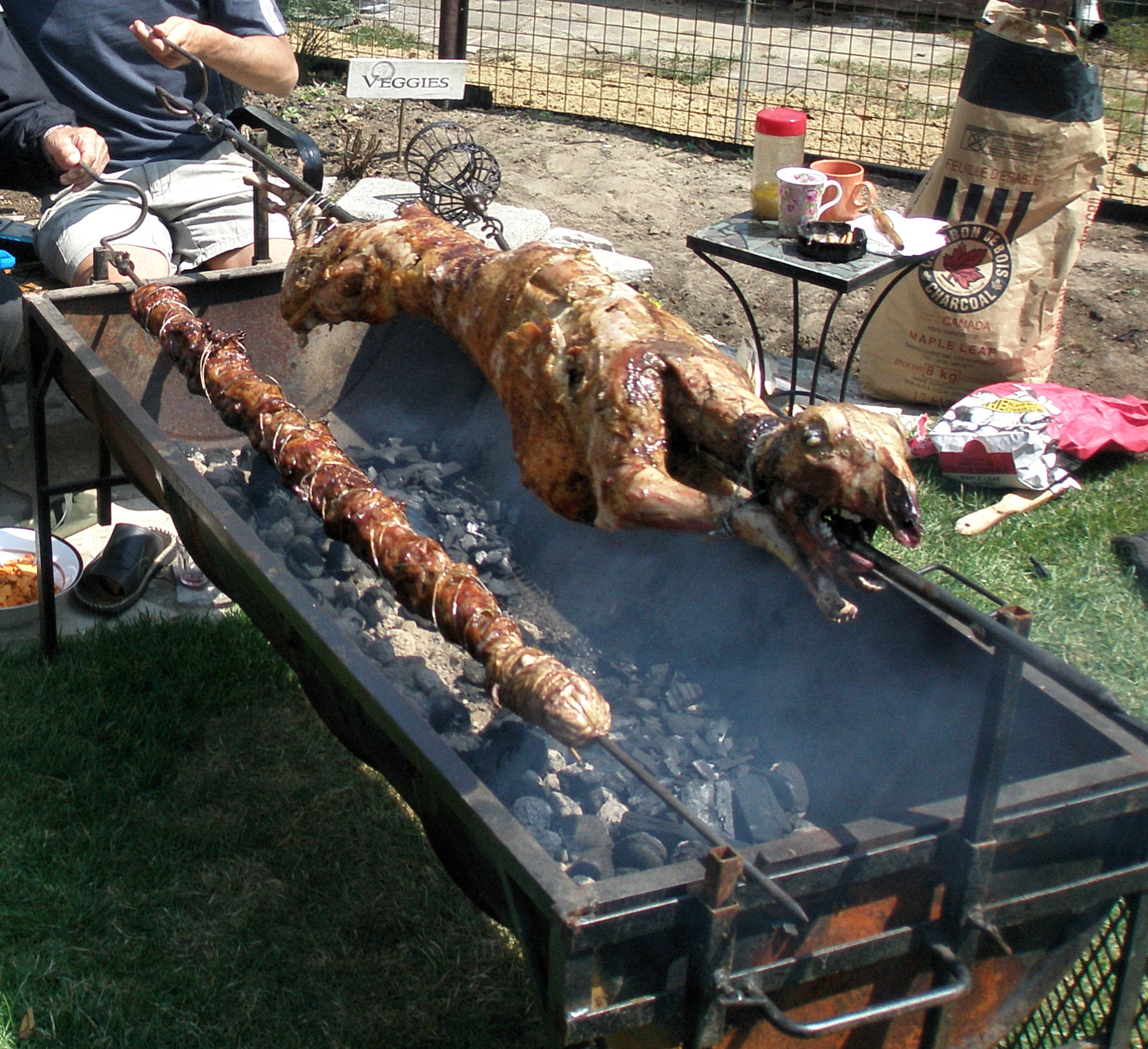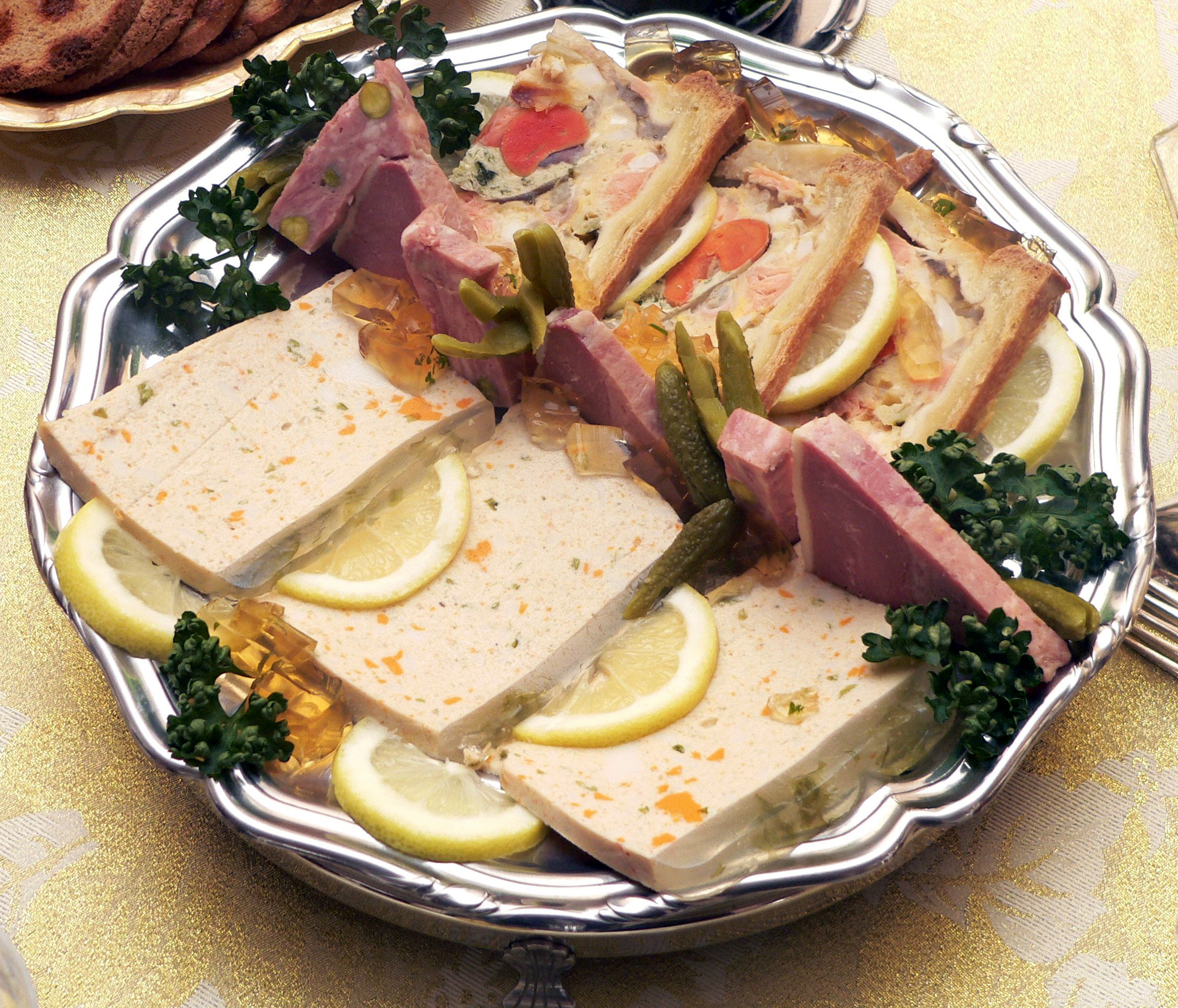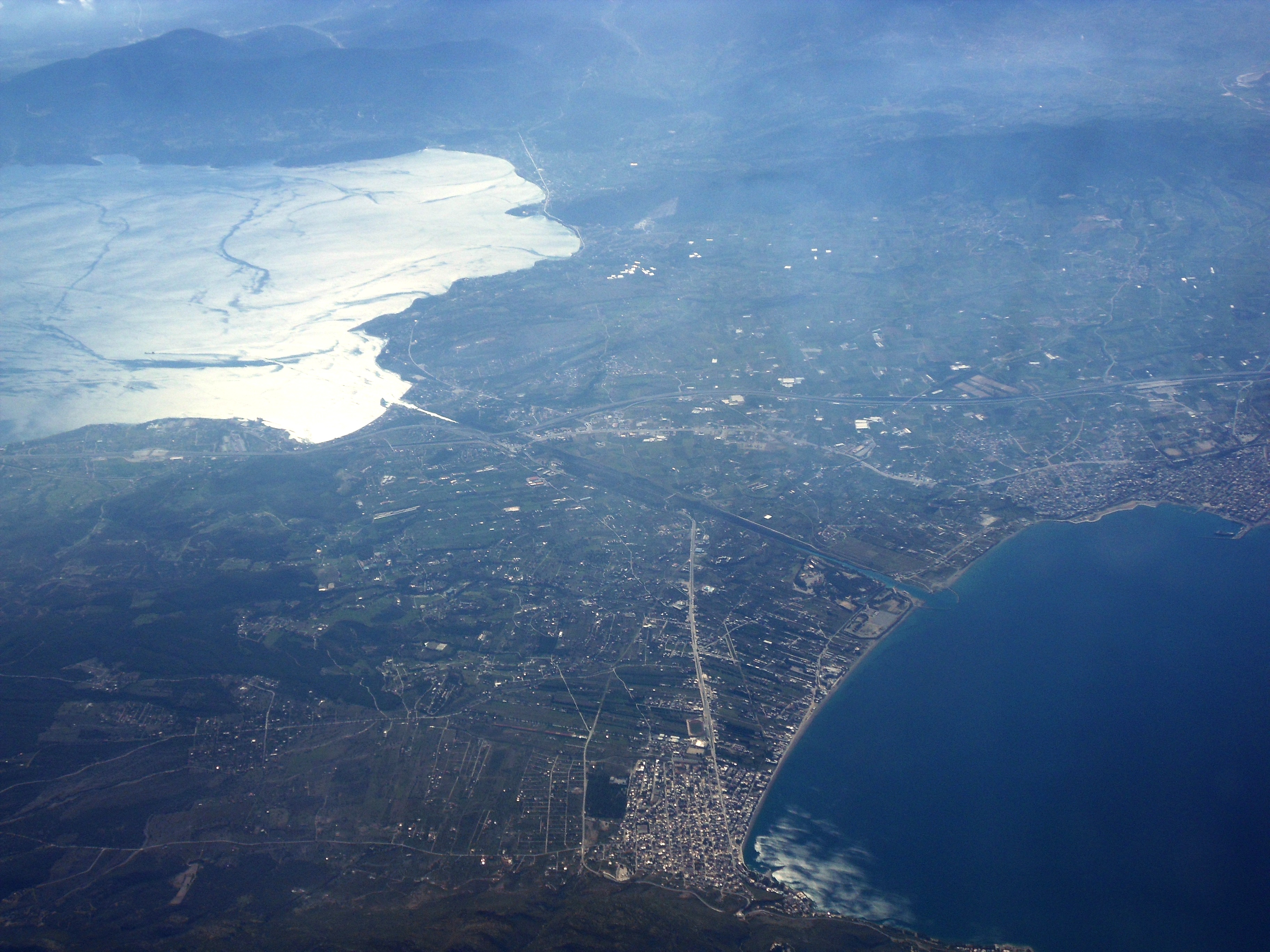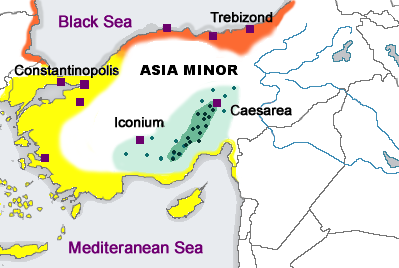|
Kokoretsi
Kokoretsi or kokoreç is a dish of the Balkans and Anatolia (Asia Minor), consisting of lamb or goat intestines wrapped around seasoned offal, including sweetbreads, hearts, lungs, or kidneys, and typically grilled; a variant consists of chopped innards cooked on a griddle. The intestines of suckling lambs are preferred. Names A dish identical to modern kokoretsi is first attested in the cuisine of the Byzantines. They called it (''plektín''), (''koilióchorda''), or (''chordókoila''); the latter two are preserved with the meaning of wrapped intestines in the Greek idioms of Corfu as (''tsoilíchourda''), of Plovdiv as (''chordókoila''), of Chios as (''soilígourda''), of Pontians as (''chordógkoila''), and in part, of Zagori and Argyrades as (''chordí''), of Thessaly as (''chourdí''), of northern Peloponnese as (''kordiá'') or (''kórda''), and of Vogatsiko as (''kourdí''). Other names found in medieval texts are (''gardoúmion'') and (''gardoúmenon ... [...More Info...] [...Related Items...] OR: [Wikipedia] [Google] [Baidu] |
Offal
Offal (), also called variety meats, pluck or organ meats, is the organs of a butchered animal. The word does not refer to a particular list of edible organs, which varies by culture and region, but usually excludes muscle. Offal may also refer to the by-products of milled grains, such as corn or wheat. Some cultures strongly consider offal as food to be taboo, while others use it as everyday food or even as delicacies. Certain offal dishes—including '' foie gras'', '' pâté'', and haggis —are internationally regarded as gourmet food in the culinary arts. Others remain part of traditional regional cuisine and may be consumed especially during holidays. This includes sweetbread, Jewish chopped liver, U.S. chitterlings, Mexican menudo, as well as many other dishes. On the other hand, intestines are traditionally used as casing for sausages. Depending on the context, ''offal'' may refer only to those parts of an animal carcass discarded after butchering or s ... [...More Info...] [...Related Items...] OR: [Wikipedia] [Google] [Baidu] |
Gut (anatomy)
The gastrointestinal tract (GI tract, digestive tract, alimentary canal) is the tract or passageway of the digestive system that leads from the mouth to the anus. The GI tract contains all the major organs of the digestive system, in humans and other animals, including the esophagus, stomach, and intestines. Food taken in through the mouth is digested to extract nutrients and absorb energy, and the waste expelled at the anus as feces. ''Gastrointestinal'' is an adjective meaning of or pertaining to the stomach and intestines. Most animals have a "through-gut" or complete digestive tract. Exceptions are more primitive ones: sponges have small pores (ostia) throughout their body for digestion and a larger dorsal pore ( osculum) for excretion, comb jellies have both a ventral mouth and dorsal anal pores, while cnidarians and acoels have a single pore for both digestion and excretion. The human gastrointestinal tract consists of the esophagus, stomach, and intestines, and is div ... [...More Info...] [...Related Items...] OR: [Wikipedia] [Google] [Baidu] |
Heart
The heart is a muscular organ found in most animals. This organ pumps blood through the blood vessels of the circulatory system. The pumped blood carries oxygen and nutrients to the body, while carrying metabolic waste such as carbon dioxide to the lungs. In humans, the heart is approximately the size of a closed fist and is located between the lungs, in the middle compartment of the chest, called the mediastinum. In humans, other mammals, and birds, the heart is divided into four chambers: upper left and right atria and lower left and right ventricles. Commonly, the right atrium and ventricle are referred together as the right heart and their left counterparts as the left heart. Fish, in contrast, have two chambers, an atrium and a ventricle, while most reptiles have three chambers. In a healthy heart, blood flows one way through the heart due to heart valves, which prevent backflow. The heart is enclosed in a protective sac, the pericardium, which also contains ... [...More Info...] [...Related Items...] OR: [Wikipedia] [Google] [Baidu] |
Peloponnese
The Peloponnese (), Peloponnesus (; el, Πελοπόννησος, Pelopónnēsos,(), or Morea is a peninsula and geographic region in southern Greece. It is connected to the central part of the country by the Isthmus of Corinth land bridge which separates the Gulf of Corinth from the Saronic Gulf. From the late Middle Ages until the 19th century the peninsula was known as the Morea ( grc-x-byzant, Μωρέας), (Morèas) a name still in colloquial use in its demotic form ( el, Μωριάς, links=no), (Moriàs). The peninsula is divided among three administrative regions: most belongs to the Peloponnese region, with smaller parts belonging to the West Greece and Attica regions. Geography The Peloponnese is a peninsula located at the southern tip of the mainland, in area, and constitutes the southernmost part of mainland Greece. It is connected to the mainland by the Isthmus of Corinth, where the Corinth Canal was constructed in 1893. However, it is also connected ... [...More Info...] [...Related Items...] OR: [Wikipedia] [Google] [Baidu] |
Vogatsiko
Vogatsiko ( el, Βογατσικό, ''Vogatsikó'') is a village and a community in northern Greece in the region of Western Macedonia, located at the southeast corner of Kastoria regional unit. Between 1997 and 2010, it was the seat of the municipality of Ion Dragoumis. The population was 549 at the 2011 census. It is surrounded by mountains on three sides and overlooks a valley through which Aliakmon river passes. According to the statistics of Vasil Kanchov ("Macedonia, Ethnography and Statistics"), 1.750 Greek Christians lived in the village in 1900. Kanchov, Vasil, , Sofia, 1900, book 2, p. 43. Written as "Богацко (Богатско)". (in Bulgarian) The village has a rich history, including being the origin of the Dragoumis family and its most notable member, Ion Dragoumis Ion Dragoumis (; 14 September 1878 – 31 July 1920) was a Greek diplomat, philosopher, writer and revolutionary. Biography Born in Athens, Dragoumis was the son of Stephanos Dragoumis who wa ... [...More Info...] [...Related Items...] OR: [Wikipedia] [Google] [Baidu] |
Greece
Greece,, or , romanized: ', officially the Hellenic Republic, is a country in Southeast Europe. It is situated on the southern tip of the Balkans, and is located at the crossroads of Europe, Asia, and Africa. Greece shares land borders with Albania to the northwest, North Macedonia and Bulgaria to the north, and Turkey to the northeast. The Aegean Sea lies to the east of the mainland, the Ionian Sea to the west, and the Sea of Crete and the Mediterranean Sea to the south. Greece has the longest coastline on the Mediterranean Basin, featuring thousands of islands. The country consists of nine traditional geographic regions, and has a population of approximately 10.4 million. Athens is the nation's capital and largest city, followed by Thessaloniki and Patras. Greece is considered the cradle of Western civilization, being the birthplace of democracy, Western philosophy, Western literature, historiography, political science, major scientific and mathematical p ... [...More Info...] [...Related Items...] OR: [Wikipedia] [Google] [Baidu] |
Medieval Greek
Medieval Greek (also known as Middle Greek, Byzantine Greek, or Romaic) is the stage of the Greek language between the end of classical antiquity in the 5th–6th centuries and the end of the Middle Ages, conventionally dated to the Ottoman conquest of Constantinople in 1453. From the 7th century onwards, Greek was the only language of administration and government in the Byzantine Empire. This stage of language is thus described as Byzantine Greek. The study of the Medieval Greek language and literature is a branch of Byzantine studies, the study of the history and culture of the Byzantine Empire. The beginning of Medieval Greek is occasionally dated back to as early as the 4th century, either to 330 AD, when the political centre of the Roman Empire was moved to Constantinople, or to 395 AD, the division of the empire. However, this approach is rather arbitrary as it is more an assumption of political, as opposed to cultural and linguistic, developments. Indeed, by this time ... [...More Info...] [...Related Items...] OR: [Wikipedia] [Google] [Baidu] |
Latin
Latin (, or , ) is a classical language belonging to the Italic branch of the Indo-European languages. Latin was originally a dialect spoken in the lower Tiber area (then known as Latium) around present-day Rome, but through the power of the Roman Republic it became the dominant language in the Italian region and subsequently throughout the Roman Empire. Even after the fall of Western Rome, Latin remained the common language of international communication, science, scholarship and academia in Europe until well into the 18th century, when other regional vernaculars (including its own descendants, the Romance languages) supplanted it in common academic and political usage, and it eventually became a dead language in the modern linguistic definition. Latin is a highly inflected language, with three distinct genders (masculine, feminine, and neuter), six or seven noun cases (nominative, accusative, genitive, dative, ablative, and vocative), five declensions, four ... [...More Info...] [...Related Items...] OR: [Wikipedia] [Google] [Baidu] |
Byzantine Empire
The Byzantine Empire, also referred to as the Eastern Roman Empire or Byzantium, was the continuation of the Roman Empire primarily in its eastern provinces during Late Antiquity and the Middle Ages, when its capital city was Constantinople. It survived the fragmentation and fall of the Western Roman Empire in the 5th century AD and continued to exist for an additional thousand years until the fall of Constantinople to the Ottoman Empire in 1453. During most of its existence, the empire remained the most powerful economic, cultural, and military force in Europe. The terms "Byzantine Empire" and "Eastern Roman Empire" were coined after the end of the realm; its citizens continued to refer to their empire as the Roman Empire, and to themselves as Romans—a term which Greeks continued to use for themselves into Ottoman times. Although the Roman state continued and its traditions were maintained, modern historians prefer to differentiate the Byzantine Empire from Ancient ... [...More Info...] [...Related Items...] OR: [Wikipedia] [Google] [Baidu] |
Argyrades
Argyrades ( el, Αργυράδες) is a village and a community in the southern part of the island of Corfu, Greece. It was the seat of the municipality of Korissia. In 2011 its population was 660 for the village and 1,719 for the community, which includes the villages Agios Georgios (pop. 503), Marathias (pop. 331) and Neochoraki (pop. 225). Argyrades is situated in low hills, 4 km east of the Korissia Lagoon. It is 4 km northwest of Perivoli, 8 km west of Lefkimmi and 22 km south of the city of Corfu. The Greek National Road 25 Greek may refer to: Greece Anything of, from, or related to Greece, a country in Southern Europe: *Greeks, an ethnic group. *Greek language, a branch of the Indo-European language family. **Proto-Greek language, the assumed last common ancestor ... (Corfu - Lefkimmi) passes through the village. Population See also * List of settlements in the Corfu regional unit References External links Argyrades at the GTP Travel Pages ... [...More Info...] [...Related Items...] OR: [Wikipedia] [Google] [Baidu] |
Georgios Babiniotis
Georgios Babiniotis ( el, Γεώργιος Μπαμπινιώτης; born 6 January 1939) is a Greek linguist and philologist and former Minister of Education and Religious Affairs of Greece. He previously served as rector of Athens University. As a linguist, he is best known as the author of a '' Dictionary of Modern Greek'' (Λεξικό της νέας ελληνικής γλώσσας), which was published in 1998. Biography He was born in Athens, in 1939. He graduated from the 9th Boys' Gymnasium of Athens and then he studied philology at the School of Philosophy of the University of Athens. In 1962 he earned his bachelor's degree from the University of Athens and he continued his studies in Greece and Germany. Before his 35th birthday, he became a full professor of linguistics at the Department of Philology of the School of Philosophy of the University of Athens. In 1991 he was elected president of the Philology Section of the Philosophy School and in 2000 he was elected ... [...More Info...] [...Related Items...] OR: [Wikipedia] [Google] [Baidu] |






